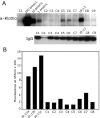A translocation causing increased alpha-klotho level results in hypophosphatemic rickets and hyperparathyroidism
- PMID: 18308935
- PMCID: PMC2265125
- DOI: 10.1073/pnas.0712361105
A translocation causing increased alpha-klotho level results in hypophosphatemic rickets and hyperparathyroidism
Abstract
Phosphate homeostasis is central to diverse physiologic processes including energy homeostasis, formation of lipid bilayers, and bone formation. Reduced phosphate levels due to excessive renal loss cause hypophosphatemic rickets, a disease characterized by prominent bone defects; conversely, hyperphosphatemia, a major complication of renal failure, is accompanied by parathyroid hyperplasia, hyperparathyroidism, and osteodystrophy. Here, we define a syndrome featuring both hypophosphatemic rickets and hyperparathyroidism due to parathyroid hyperplasia as well as other skeletal abnormalities. We show that this disease is due to a de novo translocation with a breakpoint adjacent to alpha-Klotho, which encodes a beta-glucuronidase, and is implicated in aging and regulation of FGF signaling. Plasma alpha-Klotho levels and beta-glucuronidase activity are markedly increased in the affected patient; unexpectedly, the circulating FGF23 level is also markedly elevated. These findings suggest that the elevated alpha-Klotho level mimics aspects of the normal response to hyperphosphatemia and implicate alpha-Klotho in the selective regulation of phosphate levels and in the regulation of parathyroid mass and function; they also have implications for the pathogenesis and treatment of renal osteodystrophy in patients with kidney failure.
Conflict of interest statement
The authors declare no conflict of interest.
Figures





Similar articles
-
Interrelated role of Klotho and calcium-sensing receptor in parathyroid hormone synthesis and parathyroid hyperplasia.Proc Natl Acad Sci U S A. 2018 Apr 17;115(16):E3749-E3758. doi: 10.1073/pnas.1717754115. Epub 2018 Apr 4. Proc Natl Acad Sci U S A. 2018. PMID: 29618612 Free PMC article.
-
Soluble Klotho causes hypomineralization in Klotho-deficient mice.J Endocrinol. 2018 Jun;237(3):285-300. doi: 10.1530/JOE-17-0683. Epub 2018 Apr 9. J Endocrinol. 2018. PMID: 29632215
-
FGF23-FGF Receptor/Klotho Pathway as a New Drug Target for Disorders of Bone and Mineral Metabolism.Calcif Tissue Int. 2016 Apr;98(4):334-40. doi: 10.1007/s00223-015-0029-y. Epub 2015 Jul 1. Calcif Tissue Int. 2016. PMID: 26126937 Review.
-
Emerging role of fibroblast growth factor 23 in a bone-kidney axis regulating systemic phosphate homeostasis and extracellular matrix mineralization.Curr Opin Nephrol Hypertens. 2007 Jul;16(4):329-35. doi: 10.1097/MNH.0b013e3281ca6ffd. Curr Opin Nephrol Hypertens. 2007. PMID: 17565275 Review.
-
FGF23 and Bone and Mineral Metabolism.Handb Exp Pharmacol. 2020;262:281-308. doi: 10.1007/164_2019_330. Handb Exp Pharmacol. 2020. PMID: 31792685
Cited by
-
The expanding family of hypophosphatemic syndromes.J Bone Miner Metab. 2012 Jan;30(1):1-9. doi: 10.1007/s00774-011-0340-2. Epub 2011 Dec 14. J Bone Miner Metab. 2012. PMID: 22167381 Review.
-
Molecular Control of Phosphorus Homeostasis and Precision Treatment of Hypophosphatemic Disorders.Curr Mol Biol Rep. 2019 Jun;5(2):75-85. doi: 10.1007/s40610-019-0118-1. Epub 2019 Feb 9. Curr Mol Biol Rep. 2019. PMID: 31871877 Free PMC article.
-
PHEX analysis in 118 pedigrees reveals new genetic clues in hypophosphatemic rickets.Hum Genet. 2009 May;125(4):401-11. doi: 10.1007/s00439-009-0631-z. Epub 2009 Feb 15. Hum Genet. 2009. PMID: 19219621
-
The regulation of FGF23 under physiological and pathophysiological conditions.Pflugers Arch. 2022 Mar;474(3):281-292. doi: 10.1007/s00424-022-02668-w. Epub 2022 Jan 27. Pflugers Arch. 2022. PMID: 35084563 Free PMC article. Review.
-
Genetics of Refractory Rickets: Identification of Novel PHEX Mutations in Indian Patients and a Literature Update.J Pediatr Genet. 2018 Jun;7(2):47-59. doi: 10.1055/s-0038-1624577. Epub 2018 Jan 28. J Pediatr Genet. 2018. PMID: 29707405 Free PMC article. Review.
References
-
- Holm IA, et al. Mutational analysis and genotype-phenotype correlation of the PHEX gene in X-linked hypophosphatemic rickets. J Clin Endocrinol Metab. 2001;86:3889–3899. - PubMed
-
- Tenenhouse H. Regulation of phosphorus homeostasis by the type IIa Na/phosphate cotransporter. Annu Rev Nutr. 2005;25:197–214. - PubMed
-
- Forster IC, Hernando N, Biber J, Murer H. Proximal tubular handling of phosphate: A molecular perspective. Kidney Int. 2006;70:1548–1559. - PubMed
Publication types
MeSH terms
Substances
Grants and funding
LinkOut - more resources
Full Text Sources
Other Literature Sources
Medical
Molecular Biology Databases
Research Materials

